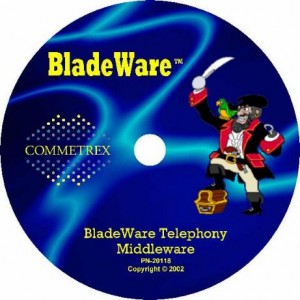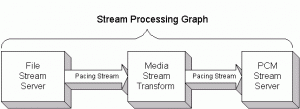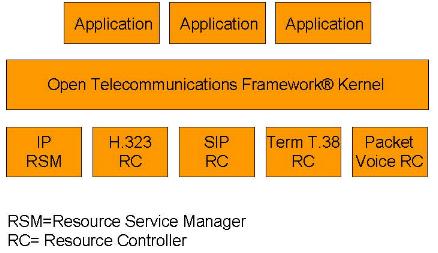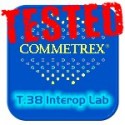Streams Framework
Every telephony system that requires call-stream signal processing has a software framework responsible for binding a media-processing resource (hardware and software) to a call stream.
 If the system supports multiple calls and multiple media, the necessary software framework can represent a significant portion of total system complexity and development cost. Although complexity can be reduced by making this binding static, this is a poor tradeoff when the resulting reduction in resource utilization and system scalability are considered. This means a software framework is required that dynamically binds a call-stream processing resource to a stream source and a stream sink under the control of the application-level software. Commetrex models this with a stream graph, as shown below.
If the system supports multiple calls and multiple media, the necessary software framework can represent a significant portion of total system complexity and development cost. Although complexity can be reduced by making this binding static, this is a poor tradeoff when the resulting reduction in resource utilization and system scalability are considered. This means a software framework is required that dynamically binds a call-stream processing resource to a stream source and a stream sink under the control of the application-level software. Commetrex models this with a stream graph, as shown below.
 The stream graph is built under the direction of a media-specific service entity that acts at the behest of a client application, as depicted in the previous diagram. The media controller will accept commands, build the stream graph, start the graph, send events to the client, and tear down the stream graph when the call is complete, freeing the resources.
The stream graph is built under the direction of a media-specific service entity that acts at the behest of a client application, as depicted in the previous diagram. The media controller will accept commands, build the stream graph, start the graph, send events to the client, and tear down the stream graph when the call is complete, freeing the resources.
Such an environment can be just as suitable to execution on a host computer as on a DSP or distributed across multiple processors.
Partitioning a digital-media system to expose the media-streams software environment is necessary for it to become the subject of specification. Over the last several years, the MSP Consortium, Inc. has developed and published such a specification, M.100 Media Stream Processing Environment (MSP). M.100 specifies a streams environment by specifying the APIs that entities within the environment use to perform stream-processing tasks. As long as software within the environment uses these APIs, the server developer can choose technologies provided by multiple vendors.
OpenMedia is Commetrex’ implementation of the MSP Consortium M.100 streams environment, and provides the host signal-processing environment in BladeWare.
Telephony Middleware
However, an open multi-vendor streams environment that executes on multiple server blades is the business end of the total digital-media system. Client-server telephony-middleware is necessary to provide system management and services. Commetrex’ middleware is OTF Kernel, which offers the system developer:
- Control of strategic platform
- Resource independence
- Seamless scalability
- Configurability/Extensibility
- Application portability

Other than OTF Kernel, all telephony middleware products are closed-architectures bundled with the vendor’s media resources, requiring that the OEM cede control of the system platform. BladeWare’s open architecture puts the system developer back in control of the end product.
Resource independence is achieved by abstracting the media-processing resource behind a resource service manager combined with an open environment at the client API.
Seamless scalability is achieved through a distributed client-server architecture that moves command routing, resource configuration and allocation, container management, connection management, and system management to system-service entities, as shown above. Connection Management includes support for call termination as well as pre-paid and PBX connectivity. Services are invoked by name rather than by location or address.
System expansion, then, is achieved by adding a processor and configuring it through the system-management facility. Of course, clients and servers are software abstractions, making their assignment to a particular processor a function of system-availability and management considerations.
SIP Resource Service Manager
BladeWare’s SIP Resource Service Manager (RSM) has been extensively tested with a wide range of gateways and application servers and many different call scenarios. The RSM includes support for SIP Digest Authentication. And, BladeWare’s SIP RSM’s five-years of field experience in supporting FoIP means network-integration problems are minimized, especially with Smart FoIP.
Reliably transporting a fax that originates in a ‘traditional’ fax terminal over a packet network to a receiving terminal in real-time requires that a fax-relay be situated between each terminal and the packet network. These entities—the relays—must render the delays and timing uncertainties of packet networks transparent to the T.30 protocol engines operating on the transmitting and receiving legacy terminals.
 Smart FoIP, Commetrex’ patent-applied-for technology, is optionally available with T.38 fax relay for use in SIP networks. Smart FoIP eliminates the problems caused by late-arriving T.38 re-INVITES from the receiving gateway that can cause the call to fail if incorrectly accepted by the calling gateway.
Smart FoIP, Commetrex’ patent-applied-for technology, is optionally available with T.38 fax relay for use in SIP networks. Smart FoIP eliminates the problems caused by late-arriving T.38 re-INVITES from the receiving gateway that can cause the call to fail if incorrectly accepted by the calling gateway.
Commetrex has found that significant practical problems with SIP negotiations exist in carrier-based SIP networks. After much testing and analysis, we have developed what we call “Smart FoIP”, which improves the reliability of fax-session establishment for ATAs and access gateways. The technology increases the likelihood of a session remaining in G.711 fax pass-through mode, so it also includes a new technology that eliminates PCM-clock synchronization problems.
PSTN Interfaces
BladeWare supports the Sangoma A2xx and A10x PCI and PCI Express PSTN/TDM interface boards, giving the OEM the flexibility of supporting PSTN and SIP applications on the same systems.
System Administration
As shown in the diagram above, system administration is a separate entity in the distributed BladeWare system. The admin facility manages the system via “admin agents” in each system entity. The admin SDK exposes an API that the developer can use to implement proprietary administration features. The user has access through a browser-based control console.
Product Structure
As BladeWare is highly configurable by the OEM. Stream-processing technologies, such as Commetrex’ exclusive TerminatingT38 and PowerVox packet-voice technologies, can operate in the OpenMedia streams framework, which is available in SDK form, allowing the licensee to add proprietary or third-party media technologies.
Commetrex also offers three ready-to-deploy fax-server applications in SDKs that include the application’s source code. The licensee can either use the application as is, modify it to suit a specific requirement, or engage Commetrex to make the modification.

BladeWare Fax Media Server uses MSCML to interface with an application server that implements the overall system function and uses BladeWare FMS as the fax send-receive resource. SIP-based calls are redirected to the BladeWare system once the application server determines that the call requires fax services. Unified messaging, fax broadcast, and document management are typical applications.
BladeWare Fax-to-Email and BladeWare Email-to-Fax are stand-alone ready-to-deploy applications for the service provider.
FoIP Interoperability
 Commetrex has led the industry effort for T.38 interoperability since January 2002, when it launched the T.38 Interoperability Test Lab. Recently, Commetrex has done extensive interoperability testing with the BladeWare HMP telephony platform, with international carriers, service providers, and enterprises.
Commetrex has led the industry effort for T.38 interoperability since January 2002, when it launched the T.38 Interoperability Test Lab. Recently, Commetrex has done extensive interoperability testing with the BladeWare HMP telephony platform, with international carriers, service providers, and enterprises.
License Options
- Limited-use paid-up source code
- Corporate paid-up source code
- Source with runtime license
- Paid-up object code
- Object Code with Runtime Licenses
Related Publications



 If the system supports multiple calls and multiple media, the necessary software framework can represent a significant portion of total system complexity and development cost. Although complexity can be reduced by making this binding static, this is a poor tradeoff when the resulting reduction in resource utilization and system scalability are considered. This means a software framework is required that dynamically binds a call-stream processing resource to a stream source and a stream sink under the control of the application-level software. Commetrex models this with a stream graph, as shown below.
If the system supports multiple calls and multiple media, the necessary software framework can represent a significant portion of total system complexity and development cost. Although complexity can be reduced by making this binding static, this is a poor tradeoff when the resulting reduction in resource utilization and system scalability are considered. This means a software framework is required that dynamically binds a call-stream processing resource to a stream source and a stream sink under the control of the application-level software. Commetrex models this with a stream graph, as shown below. The stream graph is built under the direction of a media-specific service entity that acts at the behest of a client application, as depicted in the previous diagram. The media controller will accept commands, build the stream graph, start the graph, send events to the client, and tear down the stream graph when the call is complete, freeing the resources.
The stream graph is built under the direction of a media-specific service entity that acts at the behest of a client application, as depicted in the previous diagram. The media controller will accept commands, build the stream graph, start the graph, send events to the client, and tear down the stream graph when the call is complete, freeing the resources.
 Smart FoIP, Commetrex’ patent-applied-for technology, is optionally available with T.38 fax relay for use in SIP networks. Smart FoIP eliminates the problems caused by late-arriving T.38 re-INVITES from the receiving gateway that can cause the call to fail if incorrectly accepted by the calling gateway.
Smart FoIP, Commetrex’ patent-applied-for technology, is optionally available with T.38 fax relay for use in SIP networks. Smart FoIP eliminates the problems caused by late-arriving T.38 re-INVITES from the receiving gateway that can cause the call to fail if incorrectly accepted by the calling gateway.
 Commetrex has led the industry effort for T.38 interoperability since January 2002, when it launched the
Commetrex has led the industry effort for T.38 interoperability since January 2002, when it launched the 





